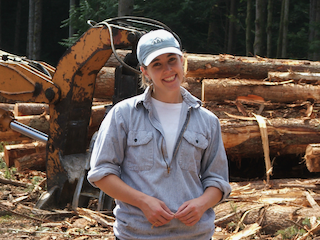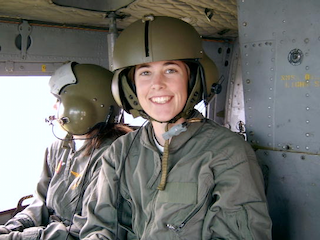Alumni Spotlight: Alicia Sullivan, Product Manager at Google for Earth Engine
Alicia Sullivan is a Product Manager at Google for Earth Engine. She graduated with her Masters of Science in Forest Resources in 2008 and while she was here she was a member of the Precision Forestry Cooperative (PFC). The PFC celebrated 25 years of pioneering research and industry engagement this year. Alicia took a moment to share her early interests in the geospatial sector, her pathway to Earth Engine at Google and what it’s like to be a woman in science in 2025.

At your time at the UW how did you come across the PFC? Did you know early on that you were interested in the geospatial sector or did the PFC help you discover that passion?
Alicia Sullivan: I came across the PFC because I was interested in the application of LiDAR for forest inventory. I originally came to graduate school as an RA for the Rural Technology Initiative but my funding ran out after my first year. Given my interest in remote sensing, and particularly LiDAR, Dr. David Briggs guided me towards the PFC and I later secured my own funding to finish my degree with support from George McFadden and funds from the Oregon Bureau of Land Management.
Before joining the PFC, I had an interest in geospatial technologies. I had been working for a few years as a forester for the Washington State Department of Natural Resources and realized a big opportunity for forestry to use more geospatial technology to make better management decisions. I also recognized that at the time, there were few professionals in forestry that had GIS / remote sensing skills and it was an opportunity for me, as well as a skill that could transfer to other industries.
What was your search for internships or jobs like? How did the PFC support you? What advice would you give to someone who is looking for work right now?
AS: When I was looking for a career, it was a different world! The PFC supported me by providing funding to go to conferences and access to alumni through various events. I was lucky that my second year in graduate school corresponded with the College of Forest Resources’ 100 year anniversary, so there were a lot of opportunities to meet alumni and professionals. I also actively sought out an internship with Weyerhauser while I was in school and that ultimately turned into a full time job.
My advice to students is to network, network, network. You never know when a casual conversation at an event can turn into a door opening to a job or funding. Both happened to me. These days, a lot of hiring has been “automated,” so having personal connections at organizations is really key. If someone knows you, and has a connection with you, even a small one, that is a huge advantage over a random resume hitting an inbox or job portal.
What are you up to now? Are you able to directly apply what you learned while at the PFC to your current role?
AS: I am currently a Product Manager at Google for Earth Engine. Earth Engine is one of the prominent remote sensing tools in the industry, so I am able to use my knowledge of remote sensing and its application to help determine product direction and work directly with customers. The background I have gained through my work at PFC has been very helpful.
What has been most surprising about your career as a woman in science? Any advice for young female students looking to pursue a career in the geospatial sector?
AS: Honestly, I have been incredibly fortunate to have had positive experiences early in my career as a woman in science. My manager at Weyerhaeuser was a wonderful role model as a leader and she really helped me to develop confidence in myself and encouraged me to develop leadership skills.
As I transitioned into tech, the surprise I had was that the culture and experiences I had were much different. Early on I really struggled to find my way in that, and felt immense pressure to change how I showed up in the workplace that didn’t always align with my personal values. I think my advice to folks coming into any role is to really think about what your personal values are and how you can stay grounded in those, especially if you find yourself in a situation that is challenging them.
How have you seen the Geospatial sector change since you graduated?
AS: The biggest thing has been the scale of what can be done, and the tools available to the sector. When I graduated, the LandSat archive was still something you had to manually request images from. Commercial tools struggled to process LiDAR and storage of data was a real challenge. I remember one of my jobs as a LiDAR analyst was figuring out how to manage the ~1TB of data we would get annually from our collections, at the time most computers had like 250GB or less of storage, and the cloud didn’t exist which made for some real challenges.
Now, that amount of data is common and stored easily in cloud systems. Along with the amount of data, the compute power that is available to run analysis today is almost infinite, whereas when I graduated you were really constrained to what a server or individual desktop could do. The tools have also evolved to meet that change in storage and compute, Earth Engine is a good example of that, and we continue to see movement of tools to cloud environments which also helps break the constraints of desktop workloads
I think that now, in 2025, more people are aware of what geospatial is, especially because of the now common use of tools like Google Maps, almost everyone is interacting with a map on a daily basis, whereas when I graduated, smart phones and mapping apps like that were still very nascent.
There is a lot of uncertainty right now in the future of environmental research. How are you staying positive in the current climate?
AS: I am fortunate enough to get to interact with so many organizations that really deeply care about the environment, and the research required to support it. I see these organizations sticking to their missions, and continuing to get funding and resources to continue their work, because I do truly believe that there has been a shift in the consciousness of most people that we need to act on the climate crisis we are facing.
What would you say to young, curious minds interested in studying the environment and some of today’s most pressing challenges?
AS: I would say, do it! Look to understand what research will help us adapt and mitigate what is happening. Be creative and don’t be constrained by what has happened in the past. I think that this generation of students, and the ones who will come after them have a really unique opportunity as “digital natives” to think differently about the climate and environment and how we choose to interact with it in the future.
